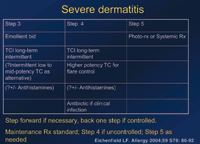- Acne
- Actinic Keratosis
- Aesthetics
- Alopecia
- Atopic Dermatitis
- Buy-and-Bill
- COVID-19
- Case-Based Roundtable
- Chronic Hand Eczema
- Chronic Spontaneous Urticaria
- Drug Watch
- Eczema
- General Dermatology
- Hidradenitis Suppurativa
- Melasma
- NP and PA
- Pediatric Dermatology
- Pigmentary Disorders
- Practice Management
- Precision Medicine and Biologics
- Prurigo Nodularis
- Psoriasis
- Psoriatic Arthritis
- Rare Disease
- Rosacea
- Skin Cancer
- Vitiligo
- Wound Care
Article
Stepwise treatment approach yields results with atopic dermatitis
Las Vegas — With the increased efficacy of topical immune modulators in the treatment of atopic dermatitis, Lawrence Eichenfield, M.D., chief of pediatric and adolescent dermatology and clinical professor of pediatrics and dermatology at the Children'sHospital in San Diego and University of California, San Diego, has established a step approach to the treatment of atopic dermatitis.

Dr. Eichenfield presented "Advances in Topical Immune Modulators" at the Fall and Winter Dermatology Conference here last fall.
"One of the reasons I wrote up treatment algorithms for atopic dermatitis is that I had been contacted by several companies that do formulary management for insurance companies," he says. "While dermatologists are very comfortable with mixing and matching therapy for atopic dermatitis, there are few published algorithms available."

TCIs including both tacrolimus and pimecrolimus have been assessed by Dr. Eichenfield and others in short-term studies.
"Results of these studies demonstrate that both tacrolimus and pimecrolimus in childhood studies were effective for short-term acute dermatitis, clearly superior to vehicle. They were not compared to corticosteroids in initial studies, but clearly slowed utility as an alternative to corticosteroids for monotherapy," Dr. Eichenfield says.
Furthermore, long-term analysis of tacrolimus as monotherapy has demonstrated it can be used safely for years without losing efficacy.
With several studies demonstrating the efficacy of TCIs in the treatment of atopic dermatitis, these agents can be used as monotherapy or in combination with topical corticosteroids. Dr. Eichenfield explains that dermatologists have been doing this for years, but are now trying to figure out how to use these agents in combination with other agents and/or figure out what is their optimal use for different sets of patients.
"TCIs clearly can be used either as therapy alone or as combination therapy. When used with topical corticosteroids they can be used in different ways. They can be used at the same time, that is administered together and combined, at different times in the same day, at fixed intervals (one agent a few days a week and another on the weekend), or they can be used sequentially, when one agent is used initially and then switched to another. One of the ways these medicines are commonly used, though there are few studies in the literature, is to use topical corticosteroids to control acute dermatitis and then transition to TCIs for maintenance treatment," Dr. Eichenfield says.
Treatment algorithms "While it is true that we individualize treatment for each patient, we also should define general methods to take care of patients. We are evolving our treatment to new algorithms and new approaches toward therapy which emphasize the dual aspects of acute control of active flares with consistent maintenance to keep the disease under more control regularly," Dr. Eichenfield says. "This is a shift in emphasis from reactive treatment to continuous disease control."
Dr. Eichenfield developed an action model that uses mild, moderate and severe designations based upon a mixture of extent of body surface area, how persistent the disease is or how frequently it recurs.
Newsletter
Like what you’re reading? Subscribe to Dermatology Times for weekly updates on therapies, innovations, and real-world practice tips.
















